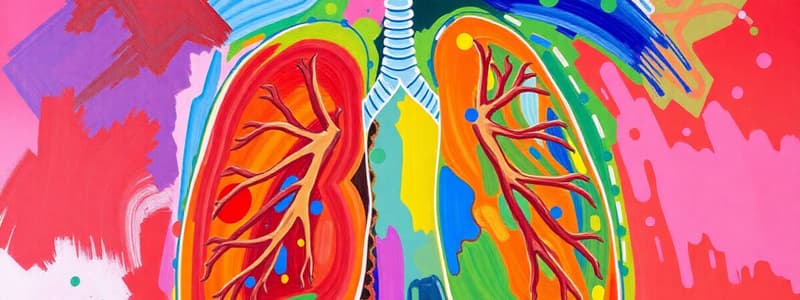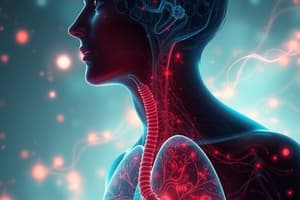Podcast
Questions and Answers
What is the product formed when hemoglobin binds with carbon dioxide?
What is the product formed when hemoglobin binds with carbon dioxide?
- HbCO2 (correct)
- HbO2
- HHb
- H2CO3
Carbonic anhydrase catalyzes the reaction between carbon dioxide and water to form carbonic acid.
Carbonic anhydrase catalyzes the reaction between carbon dioxide and water to form carbonic acid.
True (A)
What is the role of hemoglobin in buffering blood pH?
What is the role of hemoglobin in buffering blood pH?
Hemoglobin acts as a buffer by binding to hydrogen ions and carbon dioxide, helping to maintain the pH level in the blood.
The equation H2CO3 → HCO3- + H+ represents the conversion of carbonic acid to __________ and __________.
The equation H2CO3 → HCO3- + H+ represents the conversion of carbonic acid to __________ and __________.
Match the following terms with their descriptions:
Match the following terms with their descriptions:
What percentage of CO2 travels bound to hemoglobin as carbaminohemoglobin from the tissues into the blood?
What percentage of CO2 travels bound to hemoglobin as carbaminohemoglobin from the tissues into the blood?
Carbonic anhydrase helps to form carbonic acid from CO2 and water.
Carbonic anhydrase helps to form carbonic acid from CO2 and water.
What role does HCO3- play in pH regulation in the lungs?
What role does HCO3- play in pH regulation in the lungs?
During external respiration, O2 combines with Hb to form ______.
During external respiration, O2 combines with Hb to form ______.
Match the following types of hemoglobin with their descriptions:
Match the following types of hemoglobin with their descriptions:
Which ion does not accumulate in the blood surrounding the lungs due to buffering action?
Which ion does not accumulate in the blood surrounding the lungs due to buffering action?
The majority of CO2 is transported in the blood as dissolved gas.
The majority of CO2 is transported in the blood as dissolved gas.
What products are formed when carbonic acid breaks down?
What products are formed when carbonic acid breaks down?
What happens to the size of the chest cavity during exhalation?
What happens to the size of the chest cavity during exhalation?
Carbaminohemoglobin is formed when carbon dioxide attaches to hemoglobin.
Carbaminohemoglobin is formed when carbon dioxide attaches to hemoglobin.
What is the role of carbonic anhydrase in the bloodstream?
What is the role of carbonic anhydrase in the bloodstream?
During external respiration, oxygen diffuses from the alveoli into the ________.
During external respiration, oxygen diffuses from the alveoli into the ________.
Match the following substances with their roles in respiration:
Match the following substances with their roles in respiration:
What percentage of carbon dioxide is carried in the blood as bicarbonate ions?
What percentage of carbon dioxide is carried in the blood as bicarbonate ions?
The medulla oblongata is responsible for the initiation of inhalation.
The medulla oblongata is responsible for the initiation of inhalation.
What is released from bicarbonate ions when they pick up hydrogen ions?
What is released from bicarbonate ions when they pick up hydrogen ions?
Flashcards
HHb Formation
HHb Formation
Hemoglobin (Hb) combines with hydrogen ions (H+) to form HHb.
Bicarbonate Formation
Bicarbonate Formation
Carbon dioxide (CO2) reacts with water (H2O) to form carbonic acid (H2CO3), which then dissociates into bicarbonate ions (HCO3-) and hydrogen ions (H+).
Oxygen Binding to Hb
Oxygen Binding to Hb
Oxygen (O2) binds to hemoglobin (Hb) to form oxyhemoglobin (HbO2), releasing hydrogen ions (H+).
CO2 Transport by Hb
CO2 Transport by Hb
Signup and view all the flashcards
CO2 Transport via Bicarbonate
CO2 Transport via Bicarbonate
Signup and view all the flashcards
O2 + Hb <=> HbO2
O2 + Hb <=> HbO2
Signup and view all the flashcards
HbCO2 <=> Hb + CO2
HbCO2 <=> Hb + CO2
Signup and view all the flashcards
Buffering in Lungs
Buffering in Lungs
Signup and view all the flashcards
Internal Respiration
Internal Respiration
Signup and view all the flashcards
CO2 Transport: Bicarbonate
CO2 Transport: Bicarbonate
Signup and view all the flashcards
O2 Release at Tissues
O2 Release at Tissues
Signup and view all the flashcards
Reduced Hemoglobin
Reduced Hemoglobin
Signup and view all the flashcards
Exhalation Process
Exhalation Process
Signup and view all the flashcards
Stretch Receptors (in alveoli)
Stretch Receptors (in alveoli)
Signup and view all the flashcards
Medulla Oblongata Role in Breathing
Medulla Oblongata Role in Breathing
Signup and view all the flashcards
Gas Exchange (in Blood)
Gas Exchange (in Blood)
Signup and view all the flashcards
Carbon Dioxide Transport in Blood
Carbon Dioxide Transport in Blood
Signup and view all the flashcards
Oxyhemoglobin Formation
Oxyhemoglobin Formation
Signup and view all the flashcards
Concentration Gradient
Concentration Gradient
Signup and view all the flashcards
Study Notes
The Respiratory System
- The respiratory system provides the body with oxygen, crucial for energy production.
- Without oxygen, the body would cease to function within minutes.
- The respiratory system collaborates with the circulatory system to deliver oxygen to, and remove carbon dioxide from, all cells.
Four Processes
-
Breathing (Inhalation/Exhalation):
- Inhalation - Takes in oxygen:
- The rib cage expands, and the diaphragm contracts (moves downward).
- This increases the chest cavity's volume and decreases the air pressure within.
- Air rushes into the lungs.
- Exhalation - Releases carbon dioxide:
- The rib cage and diaphragm return to their resting positions.
- This decreases the chest cavity's volume and increases the air pressure within.
- Air is forced out of the lungs.
- Inhalation - Takes in oxygen:
-
External Respiration: Exchange of gases between the lungs and the blood.
-
Internal Respiration: Exchange of gases between the blood and body tissues/cells
-
Cellular Respiration: ATP production within cells:
- The formula for cellular respiration is: C6H12O6 + O2 → CO2 + H2O + ATP
Breathing: Inhalation and Exhalation
-
Inhalation:
- Increased levels of CO2 and H+ trigger the breathing center in the brain.
- The medulla oblongata sends nerve impulses.
- The rib muscles contract raising the rib cage.
- The diaphragm contracts, moving downward.
- Chest cavity expands, air pressure drops.
- Air rushes into the lungs.
-
Exhalation:
- Stretch receptors in the alveoli signal the medulla oblongata to stop signaling.
- The rib cage/diaphragm relax.
- Air pressure increases inside the chest cavity.
- Air is forced out of the lungs.
Negative Pressure
-
Breathing is driven by negative pressure in the lungs.
-
The lungs do not actively push air out. Instead, the lower air pressure inside the lungs draws air in.
Additional Receptors
- Carotid bodies: Located in the carotid artery.
- Aortic bodies: Located in the aorta.
- These receptors respond to high hydrogen ion concentration and high carbon dioxide levels in the blood, impacting breathing rates.
Gas Exchange: General Rules
- External Respiration:
- High O2 concentration in the alveoli facilitates diffusion into the bloodstream.
- Oxygen binds to hemoglobin forming oxyhemoglobin.
- Carbon Dioxide Removal:
- CO2 diffuses from the tissues into the blood.
- Some CO2 dissolves in the blood, and the rest reacts with water, forming bicarbonate ions.
- Bicarbonate ions help transport the CO2 to the lungs.
- CO2 is released from the body during exhalation.
Internal Respiration
-
Blood to Tissues:
- CO2 diffuses from the tissues into the blood stream
- Hemoglobin picks up CO2, to form carbaminohemoglobin.
- 64% of CO2 reacts with water via carbonic anhydrase to form bicarbonate (HCO3-) and hydrogen ions (H+).
- This releases O2 into the tissues.
-
The blood leaving the tissues now carries substantial amounts of carbaminohemoglobin as well as reduced hemoglobin.
Studying That Suits You
Use AI to generate personalized quizzes and flashcards to suit your learning preferences.




